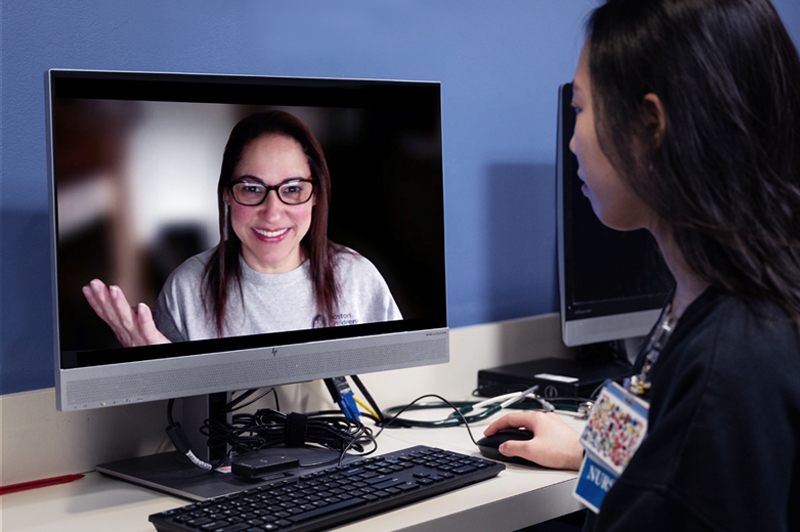Nurse-led innovations: A virtual-nursing pilot helps nurses thrive

It was night shift on the 9E Inpatient Medical Unit and Marisol Hernandez, BSN, RN, CPN, was helping another nurse review her patient assignments. With about 85 percent of their patients admitted from the emergency department (ED), nurses on the unit at Boston Children’s Hospital often don’t know how many patients will be admitted during their shift or what their diagnoses will be.
Hernandez coached the novice nurse through the kind of critical thinking that comes with time and practice: Which patients were stable? Which patients needed her most? How could she organize her workflow to make sure she met all her patients’ needs?
With 23 years of nursing experience, Hernandez helps the busy medical unit run smoothly. On this shift, however, she did so from a remote location, part of a pilot program testing the feasibility of virtual nursing. While nurses on the unit delivered hands-on care, she went over nursing assignments, answered questions, and checked medication dosages — all via computer.
“When you’re on the floor, everything is fast paced,” says Hernandez. “Having somebody available all the time to answer questions or do chart audits benefits both nurses and patients.”
Thinking differently about nursing
During 2022, as the COVID-19 pandemic began to wane, inpatient volumes rose significantly — a result of the child mental health crisis combined with respiratory viral surges and an influx of patients whose treatments had been deferred in prior years. These trends coincided with the opening of Boston Children’s new 150-bed Hale Building in June 2022. Together, they created an unprecedented demand for nurses just when workforce disruptions, including in nursing, were affecting health care systems around the country.
Boston Children’s hired nurses to help meet these escalating needs. Doing so, however, created new challenges: how to support and train a large number of graduate nurses who were new to Boston Children’s.
“Our nursing leadership realized we needed to think differently about how we deliver care and support our staff,” says Elizabeth-Anne King, DNP, RN, NE-BC, CPN, CPHQ, senior nursing director for Inpatient Medical Programs.

In December 2022, the hospital’s nursing leaders launched a virtual-nurse pilot on Boston Children’s largest inpatient medical unit. By augmenting the traditional unit-based preceptor and educator roles, they believed virtual nursing could support new members of the nursing team and reduce the demands on experienced nurses. In other words, they aimed to help nurses thrive.
The initial feedback was promising. Having easy access to an experienced nurse online helped nurses on the unit find answers to their questions quickly and — as hoped — gave them more time to spend with patients.
For senior nurses, supporting their colleagues away from the hustle and bustle of the hospital enabled them to see patient care from a different angle. “We found that virtual nurses provided a critical experience lens,” says King. “They could do deeper dives into patient charts and extrapolate data in real time while on-site nurses were busy at the bedside.”
Virtual nursing at admission and discharge
Could virtual nursing relieve workload issues on other units as well? A subsequent pilot on a nearby inpatient surgical unit, planned in collaboration with Boston Children’s Innovation and Digital Health Accelerator (IDHA) team, aimed to find out. Specifically, nurse leaders wanted to see if virtual nursing could improve hospital throughput by reducing the time patients might otherwise wait in the ED, expedite discharges, and provide other procedural support to nurses on the unit. With the IDHA team providing technical support, they rolled out a follow-up pilot in early 2024.
“We know that educating patients and families starting at the time of admission is one of the best ways we can ensure parents are equipped to care for their child after discharge,” says Kierrah Leger, DNP, MS, RN, NE-BC, senior director, Inpatient Surgical Program. With a virtual nurse handling the administrative tasks, nurses on the unit could spend more time helping families prepare to care for their children when they left the hospital.

In one example, Lily Harris, BSN, RN, conducted a physical assessment and talked with the family of a patient who’d just been admitted. Meanwhile, a virtual nurse ordered equipment and paged the medical team to let them know the patient was on the floor. “You have to be on a computer to order equipment or page people,” says Harris. “It was nice to have the virtual nurse do that so I could focus on the patient.”
Leger and her colleagues also wanted to see if virtual nursing could help reduce time to discharge for patients after spinal fusion surgery. “If we can move the bar from discharging patients at 12 p.m. to 11 a.m., that’s a win,” she says. “Patients can go home sooner, and we can make that room available to another patient.”
Emma Petrillo, BSN, RN, describes how a virtual nurse reviewed discharge instructions with the family via Zoom while Petrillo gathered supplies to remove the patient’s IV. “It streamlined everything,” she says.
The future of nursing care?
In the interest of continuous improvement, each pilot has followed a plan-do-study-act (PDSA) problem-solving model. Early results have shown that virtual nursing has tremendous potential to enhance nurses’ work-life balance and work satisfaction by giving them more time to spend with patients. They’ve also shown promise toward goals such as improved workflows throughout the hospital.
“Parents really do love it,” one nurse reported after the first pilot. “I thought it would be awkward, but kids and families are so used to being online.” Many nurses have embraced the concept as well.
“The pilot opened my eyes to a different way of nursing,” says Hernandez. “We’ll always need hands-on nursing, but having a second set of eyes and a second mind making sure things get done safely — it benefits both patients and nurses.”
In 2023, Boston Children’s was selected as one of five hospitals in the Nurse-Led Care Delivery Learning and Action Network, an initiative lead by the Institute for Healthcare Improvement and Johnson & Johnson. The national effort aims to develop and test care-delivery solutions that attract and support a thriving nursing workforce. Through these efforts and many others, the nurses at Boston Children’s continue to lead the way in ensuring quality and safety for both patients and nurses.
Related Posts :
-

In a thriving gene therapy program, nursing leadership is the driving force
Gene therapy was made possible by decades of technological advances. But to execute gene therapy at scale? That would not ...
-

‘The reason I became a nurse’: Maeve’s memories of laryngeal cleft repair
Being a gastroenterology nurse is more than a profession for Maeve Lee. When she cares for patients with feeding tubes, ...
-

I’ve been there, too: What my baby’s tumor taught me as a NICU nurse
I had a toddler at home when I found out I was pregnant with my twins, Hannah and Sophie. Since ...
-

Nurses Week 2022: Leading an enterprise-wide response to COVID-19
The Infection Prevention Control (IPC) team at Boston Children’s Hospital plays an important role in the management of all ...





